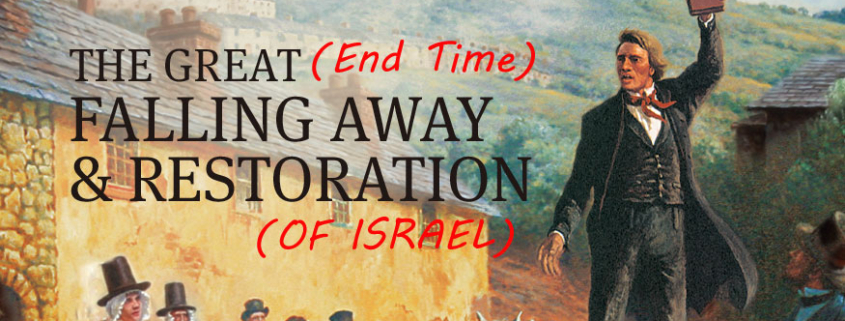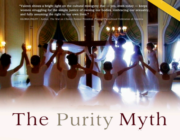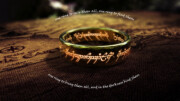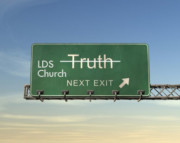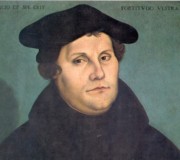Redefining the LDS View of the “Great Apostasy”
.
Confusing the Apostasy of Israel with Universal Apostasy
Perhaps one of the sources of confusion concerning traditional LDS views of Universal Apostasy stems from LDS and biblical scriptures regarding the Universal Apostasy and restoration of Israel. Readers have confused scriptures which speak of the imminent apostasy and restoration of Israel— wrongly supposing these references to Israel include the whole earth. Abrahamic religions (including Mormonism specifically) are refereed to in scripture as symbols or shadows of the manner God interacts with the earth, so its easy to see how the language could sometimes be confusing. Scriptures like Romans 11:25 show clearly that the early Apostles (or at least Paul) clearly understood that the Gospel and priesthood were to be taken from the Jews and given to the Gentiles for an entire dispensation (nearly 2000 years in this case). And that after the fulness (or end-times) of that Gentile dispensation it would then be returned to Israel. [note?] (see also, Hosea 6:2, Ezek 37, Mark 11:12–25)
For I would not, brethren, that ye should be ignorant of this mystery, lest ye should be wise in your own conceits; that blindness in part is happened to Israel, until the fulness of the Gentiles be come in. (Romans 11:25)
This statement by Paul comes directly after his explanation of the Olive tree allegory of Romans 11. Here Paul appears to be using a popular Jewish meme in which the Israeli covenant is compared to an Olive tree. Paul explains to his Gentile converts that Israel was rejected and was thus like natural branches which were cut off. The Gentiles, were like wild branches, which were grafted in place of the cut natural branches. And Israel will, if they repent, be grafted back in again at some future point.
17 If some of the branches have been broken off, and you, though a wild olive shoot, have been grafted in among the others and now share in the nourishing sap from the olive root, 18 do not consider yourself to be superior to those other branches. If you do, consider this: You do not support the root, but the root supports you. 19 You will say then, “Branches were broken off so that I could be grafted in.” 20 Granted. But they were broken off because of unbelief, and you stand by [your current] faith. Do not be arrogant, but tremble. 21 For if God did not spare the natural branches, he will not spare you either…continue in his kindness. Otherwise, you also will be cut off. 23 And if they do not persist in unbelief, they will be grafted in, for God is able to graft them in again. 24 After all, if you were cut out of an olive tree that is wild by nature, and contrary to nature were grafted into a cultivated olive tree, how much more readily will these, the natural branches, be grafted into their own olive tree!
The olive tree in this allegory represents Yahweh’s covenant people (and priesthood). The roots are generally understood to represent the gospel heritage or faith (or as I would suggest the spiritual church in heaven or underworld aspect of the covenant). The branches represent the mortal cultures or peoples of the Abrahamic covenant. LDS scripture adds an incredible amount of detail to this allegorical comparison of Israel to an olive tree in 2 Nephi 10, 15 and Jacob 5, which help to clearly show how only the original branches of Israel [in Palestine] were “cut off” from the covenant or suffered universal apostasy. The Gentiles or grafted wild branches in the allegory persist, and although wicked and devoid of fruit at the end of the second age they do not perish or get rejected and cast into the fire during the second dispensation. Instead they are spared with the original transplanted (Jewish) branches as long as they produce fruit.
29 And it came to pass that a long time had passed away, and the Lord of the vineyard said unto his servant: Come, let us go down into the vineyard, that we may labor again in the vineyard. For behold, the time [end dispensation] draweth near, and the end soon cometh; wherefore, I must lay up fruit against the season, unto mine own self. 30 And it came to pass that the Lord of the vineyard and the servant went down into the vineyard; and they came to the tree whose natural branches had been broken off, and the wild branches had been grafted in [Gentile/European Christianity]; and behold all sorts of fruit did cumber the tree. 31 And it came to pass that the Lord of the vineyard did taste of the fruit, every sort according to its number [see Rom 11:25]. And the Lord of the vineyard said: Behold, this long time have we nourished this tree, and I have laid up unto myself against the season much fruit. 32 But behold, this time it hath brought forth much fruit, and there is none of it which is good [all Gentile churches have recently become wicked]… 36 Nevertheless, I know that the roots are good, and for mine own purpose I have preserved them; and because of their much strength they have hitherto brought forth, from the wild branches, good fruit. 37 But behold, the wild branches have grown and have overrun the roots thereof; and because that the wild branches have overcome the roots thereof it hath brought forth much evil fruit; and because that it hath brought forth so much evil fruit thou beholdest that it beginneth to perish; and it will soon become ripened, that it may be cast into the fire, except we should do something for it to preserve it. (Jacob 5:29–37)
This discussion occurs at the last time or dispensation “near the end” or present latter-days, and the lord tells his servant that although the ‘mother tree’ with grafted wild branches [European Christianity], had become wicked and fruitless — it “had hitherto brought forth, from the wild branches, good fruit”. Hitherto is defined as “until now or until the point in time under discussion”. In other words, until sometime near the beginning of the final dispensation, the Gentile church had produced GOOD FRUIT. Even though Nephi’s vision (1 Ne 12-15) suggests the Spiritual Church of the devil had great hold on the people, bringing captivity and driving the good people of Europe largely into “the wilderness”— Catholicism, Islam and Reformational Christianity had still served as effective moral systems to guide Western culture and keep it civilized, ruled by moral law and free from complete social collapse and anarchy. But the lord of the vineyard saw the trouble that was brooding from the imperialism and nationalism that preceded wwi, wwii and the coming wwiii. He saw the potential collapse of the western civilization he had worked to build–and had planned to civilize the world with. He saw the building secret combinations in government, and the self destructive technology capable of destroying the entire planet. He saw the collapse that accompanies unrestrained power, selfishness, division, imperialism and most of all– a disrespect for moral principle and the rule of law. These aspects of moral decay associated with “the Fulness of the Gentiles” elaborated on by Nephi in 2 Nephi 28-31, cause the lord of the vineyard to begin an aggressive end-dispensation program of pruning and grafting. A program that restores both diasporic Israel and the Gentiles from apostasy by mixing all the people and philosophies of the world together into one divinely directed global brotherhood.
LDS Restorationism, Jewish Zionism and the End of the Age
This rebellion or departing accompanying the separation of the wheat and the tares and the END of the age or dispensation is what Paul’s “Apostasy” of 2 Thes. 2:3 is clearly referring to. The end-age gathering separates the sons of God from the sons of perdition or antiChrists—allowing the righteous to be adopted into the new dispensation. In fact, the fulness of this event of “gathering” is described in books like John’s Revelation and Oahspe, as being far more prominent in the afterworld than on earth (Rev 4, 13-19). [4] LDS scripture suggest that like Jesus was two millennia ago, Joseph Smith and other 17th century religious reformers were meant to be living archetypes or harbingers of a reformational gathering process that has accompanied the modern/industrial age. In fact both Islam and Hindu scripture also point to these end-cycle reforming archetypes as well (referred to as Mahdi, Maitreya, Kalki). The Book of Mormon gives the most detailed description of the end of the Gentile dispensation and a warning that the latter-day work accompanying the restoration of the Israeli dispensation was a sign to modern nations and religions that they must correct their practices, and follow the advice of modern reformers or they would be desolated or “cut off” from the covenant in the same way the Jews and Middle Eastern cultures were “cut off” and slowly fell to ruin at the end of the last age—as the seat of regional power moved to Europe.
1 And verily I say unto you, I give unto you a sign, that ye may know the time when these things shall be about to take place—that I shall gather in, from their long dispersion, my people, O house of Israel, and shall establish again among them my Zion;
2 And behold, this is the thing which I will give unto you for a sign—for verily I say unto you that when these things which I declare unto you, and which I shall declare unto you hereafter of myself, and by the power of the Holy Ghost which shall be given unto you of the Father, shall be made known unto the Gentiles …
7…it shall be a sign unto them, that they may know that the work of the Father hath already commenced unto the fulfilling of the covenant which he hath made unto the people who are of the house of Israel…
11 Therefore it shall come to pass that whosoever will not believe in my words, who am Jesus Christ, which the Father shall cause him [the latter-day servant or archetype] to bring forth unto the Gentiles, and shall give unto him power that he shall bring them forth unto the Gentiles, (it shall be done even as Moses said) they shall be cut off from among my people who are of the covenant.
12 And my people who are a remnant of Jacob shall be among the Gentiles, yea, in the midst of them as a lion among the beasts of the forest, as a young lion among the flocks of sheep, who, if he go through both treadeth down and teareth in pieces, and none can deliver.
13 Their hand shall be lifted up upon their adversaries, and all their enemies shall be cut off.
14 Yea, wo be unto the Gentiles except they repent; for it shall come to pass in that day, saith the Father, that I will cut [thee] off…
22 But if they will repent and hearken unto my words, and harden not their hearts, I will establish my church among them, and they shall come in unto the covenant and be numbered among this the remnant of Jacob…
23 And they shall assist my people, the remnant of Jacob, and also as many of the house of Israel as shall come…
24 And then shall they assist my people that they may be gathered in… (3 Nephi 21:1–24)
These verses and associated chapters of 2 Nephi 11-30 weave together a slew of biblical allusions to make the argument that the end of the Gentile dispensation or fulness of the Gentiles (refs) would be the apogee of global war and wickedness, where secret combinations (hidden special interest groups), priestcrafts (divisive religious ideologies), murders and strifes (war and the industrial military complex) would bring about some type of apocalyptic world war. And that this world war would divide the Nations of the Gentiles into two groups—a Christ and antichrist group. The multidimensional metaphors in the Book of Revelation, and their allusions to the Book of Daniel point our minds not only to the parallelism of these prophecies in applying to both the end of the Times of Israel and the times of the Gentiles, but also to a dual temporal and spiritual aspect, where all major earthly events are made analogs of things going on in heaven as well.
These verses and the chapters they come out of, suggest that just as the Christian Goths, Germanic nations and Northern Asians completely destroyed Rome, Greece, Persia and the relics of the Middle Eastern empires during the dispensation of the Gentiles — with this new change in dispensations the reverse will happen. The Middle Eastern cultures will again rise to power and destroy any of the Northern Gentile cultures which don’t repent of their detrimental social practices and join the coming Global religious movements started by these 19th century reformers. D&C 10 makes this same point, but clarifying that God’s “church” mentioned in verse 22 is a spiritual church with loose pluralistic meaning. And that same dispensational change that is to occur in Eurasia is also to occur in the Americas, with social power switching back to the Native peoples. (see more clarification of these verses in this in the article Re-examining the Only True Church Doctrine)
52 And now, behold, according to [the prayers of ancient Native Americans] will I bring this part of my gospel to the knowledge of my people. Behold, I do not bring it to destroy that which they have received, but to build it up…
53 And for this cause have I said: If this generation harden not their hearts, I will establish my [spiritual] church among them.
54 Now I do not say this to destroy my [spiritual] church, but I say this to build up my church;
55 Therefore, whosoever belongeth to my [spiritual] church need not fear, for such shall inherit the kingdom of heaven.
56 But it is they who do not fear me, neither keep my commandments but build up churches unto themselves to get gain, yea, and all those that do wickedly and build up the kingdom of the devil—yea, verily, verily, I say unto you, that it is they that I will disturb, and cause to tremble and shake to the center…
60 And I will show unto this people that I had other sheep, and that they were a branch of the house of Jacob…
62 Yea, and I will also bring to light my gospel which was ministered unto them, and, behold, they shall not deny that which you have received, but they shall build it up, and shall bring to light the true points of my doctrine, yea, and the only doctrine which is in me.
63 And this I do that I may establish my gospel, that there may not be so much contention; yea, Satan doth stir up the hearts of the people to contention concerning the points of my doctrine…
65 For, behold, I will gather them as a hen gathereth her chickens under her wings, if they will not harden their hearts; (D&C 10:52–63. Read also v. 64-69!)
The Book of Mormon weaves together hundreds of Biblical verses to forward this idea of global Israeli dispensationalism, and a restoration of the Abrahamic Covenant to its original cultures. The LDS Doctrine and Covenents suggest that just as the USA and Mormonism were to serve as symbols and epogees of the restoration of the Northern Kingdom of Ephraim — Jewish Zionism and a parallel modern day restoration of Israel were to serve as the epogees for the restoration of the Southern Kingdom of Judah (D&C 98:17; 18:26; D&C 45:18–44; 77:9-15; 109:62-66; D&C 133:12–14,34–35; Ether 13:3–12, 1 Nephi 13:42 JS Matthew 24). The eventual reconciliation of the doctrines and political realities that arose from these two movements would then eventually bring peace and harmony to the world (Isa 11) [3].
Talk about Ether and how the first would be last and last would be first each in their dispensation (jews, tribes, gentiles > gentiles, tribes, jews?). First unto the Jews through Peter (without much success), then to the Gentiles through Paul (with huge success). Lastly unto the Gentiles (through Joseph Smith without much success) then to the Jews/Arabs through Ben Katrhen (with huge success).
Conclusion
The LDS “restoration” was certainly not a restoration of all truth, or the full Gospel, or the full priesthood; it was a religious archetype of the very beginning of the restoration of Israel with renewal of accompanied priesthood keys and gospel truths. It serves as the harbinger for the eventual restoration of the fullness of truth, which includes both religious and political and scientific knowledge. The LDS church is not the epogee of restoration, but a shadow, symbol or harbinger of the great social, political, technological and spiritual restoration God has brought and is bring to the world at large. It has little to do with “restoring a knowledge of the nature of God“. Early Jewish and Catholic fathers hashed that one out much better than we have yet, and LDS theology ultimately adds very little to the debate concerning first cause, demiGods and the nature of the uncreated Most High God. It has little to do with restoring lost priesthood. Each dispensation is given the priesthood keys they need, for the space of time they’ll be needed and Catholic keys sufficed for the work they were given. Instead it has to do with helping to usher in a new age — the end of the age of U.S. and European Christian Imperialism and the beginning of the age of universal brotherhood and global equality.
The LDS church has been created to play a key role as the symbol or Ensign to the restored Ephraimitic or Northern Kingdom which in turn was created to be a symbol or archetype of Western/Christian thought and democratic culture (as opposed to the coming Jewish restoration–Judah being a symbol of Eastern/Islamic thought and autocratic culture). It has to do with a renewal of symbolic priesthood keys concerning the dispensation of the fulness of times. A time when the histories, technologies, philosophies and issues of every past dispensation will be restored to earth and reconciled. Issues and philosophies such as autocratic rule versus democratic rule. Of polytheism versus monotheism; resurrection versus reincarnation; legalism versus antinomianism, priesthood versus protestantism, of socialism versus capitalism, republic versus empire, Islam versus Christianity. A global restoration like that mentioned in D&C 121
26 God shall give unto [his Saints] knowledge by his Holy Spirit, yea, by the unspeakable gift of the Holy Ghost, that has not been revealed since the world was until now.
27 Which our forefathers have awaited with anxious expectation to be revealed in the last times…
28 A time to come in the which nothing shall be withheld, whether there be one God or many gods, they shall be manifest.
29 All thrones and dominions, principalities and powers, shall be revealed and set forth upon all who have endured valiantly for the gospel of Jesus Christ.
30 And also, if there be bounds set to the heavens or to the seas, or to the dry land, or to the sun, moon, or stars—
31 All the times of their revolutions, all the appointed days, months, and years, and all the days of their days, months, and years, and all their glories, laws, and set times, shall be revealed in the days of the dispensation of the fulness of times—
32 According to that which was ordained in the midst of the Council of the Eternal God of all other gods before this world was, that should be reserved unto the finishing and the end thereof, when every man shall enter into his eternal presence and into his immortal rest. (D&C 121:27–32)
Other Articles In This Series
Article 1. Re-examining what LDS scriptures say about the ‘Only True Church’ doctrine.
Article 2. A Doctrinal Look at The Universal Priesthood of God & Its Relationship to LDS exclusive truth claims.
Article 3. Re-examining the LDS adoption of the protestant fundamentalist view of the “Great Apostasy”.
Article 4. Clearing up Misunderstandings in the LDS View of the Afterlife (The 3 Degrees of Glory and their support for religious pluralism)
.
As an afterthought, watch this video and understand the rift that was created between Gentile Christianity and Jewish Christianity by the Nicene Creed (and its after affects manifested by the letter). Noting that the LDS church is a restoration of the House of Ephraim, just as the nation of Israel is a restoration of the house of Judah we can understand why early LDS prophets denounced the council of Nicaea and often considered it the beginning of the ‘Great Apostacy’. But the point of the article is to show that it was an apostacy of Israel & Israeli Christianity.. not an apostacy of Christianity in general.
.
to add?
The promised “Fullness of the Gospel” mentioned in scripture (1 Ne 10:14; 13:24; 15:3; D&C 20:9; 42:12, 90:11). Scriptures explaining and defining the restoration of the Gospel, never suggest or necessitate universal apostasy of truth, priesthood or the gospel program. In fact they preclude it by talking about the existence of Christ’s Church before the LDS restoration (D&C 10:54–56), God’s priesthood before it’s restoration to Joseph (D&C 86:8–10), the Gentile church’s efficacy before its eventual end-time apostasy (Jacob 5:32), and more often than not use words like “renew” and ” ” to explain its renewal…
this should come as no surprise since LDS scripture also makes it clear that certain aspects of priesthood are a fundamental right to those who receive them “through all their generations” (D&C 107:15–16,76; D&C 78:11; D&C 84:17–18; Abr 1:4, 2:11). However, God does renew the priesthood and restore certain keys to the priesthood at the beginning of every dispensation (D&C 84:48; D&C 27:13; 112:31). We certainly need not use any of this information to suppose that the keys Joseph Smith claimed angel’s renewed and restored to him were unneeded or unimportant, but simply that the restoration of new priesthood keys does not mean that the keys given to previous dispensations, were taken from the earth before that dispensation even really had a chance to take off. [Note:D&C 121:? makes it clear that priesthood authority is invalidated with wickedness… however, there is no evidence to support that priesthood holders such as John the Baptist or Elijah or Lehi or Alma had to be regiven the priesthood just because one of their ancestors was unworthy]
.
Note that although D&C 10 clearly speaks of God’s “church” existing on earth before the restoration of Mormonism, Joseph Smith’s early Book of Commandments (ch 4) makes it clear that “if the people of this generation harden not their hearts”, God would “work a reformation among them” putting “down all lyings and deceivings and priestcrafts, and envying and strifes and idolatries and sorceries… and [would] establish [his] church like unto the church which was taught by [Christ’s] disciples in the days of old”. Later this revelation is reworded to become D&C 5, where instead of “reformation and restoration”, the idea is given that the true church has been chased “in the wilderness”. (wilderness because you cannot see him- D&C 88:66).
14 And to none else will I grant this power, to receive this same testimony among this generation, in this the beginning of the rising up and the coming forth of my church out of the wilderness—clear as the moon, and fair as the sun, and terrible as an army with banners.
Some could use that to promote the idea that the church/kingdom (like the manchild of Revelation 12) was chased into the spirit world — and that the prevailing LDS view of apostasy and restoration was valid. But that would contradict D&C 10. More likely, as I say in my true church article, the true spiritual church was chased into hiding within the world’s existing nations and religions.

